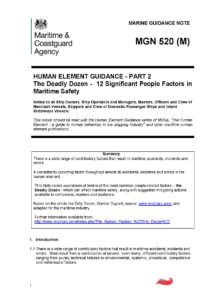Analysis of CHIRP* near-miss reports for the period 2003-2015 reveals important facts. Described as the “Deadly Dozen”, and published in the UK MCA’s Marine Guidance Note MGN 520 (M) in December 2016, the analysis has identified twelve important factors in maritime safety. Situation Awareness is found at the top of the list. 22.5% of the reported incidents are attributed to lack of Situation Awareness according to the analysis. Alerting ends up in second place followed by Communication as number three. This is the complete list:
- Situation Awareness – 22.5%
- Alerting – 15.3%
- Communication – 13.4%
- Complacency – 12.6%
- Culture – 11.4%
- Local practices – 7.4%
- Teamwork – 6.8%
- Capability – 4.9%
- Pressure – 1.9%
- Distractions – 1.8%
- Fatigue – 1.2%
- Fit for duty – 0.8%
The results of the analysis come as no surprise to MRM training providers. These areas have been key priority areas in the MRM training programme ever since resource management training was introduced in the maritime industry in the early 1990s. The list of factors is in fact very similar to the MRM course syllabus, even if the term ‘Challenge and Response’ is used instead of ‘Alerting’. Flag States’ recognition of human and organizational factors in maritime safety is very welcomed indeed. This has taken a long, long time and we are still not where we would like to be in the maritime industry. Accidents still take place at a higher frequency than needed but we are slowly moving in the right direction. The statistics produced by CHIRP and UK MCA is helpful.
More information about the “Deadly Dozen” is found in the UK’s Maritime & Coastguard Agency’s Marine Guidance Note MGN 520 (M). The document is definitely worthwhile reading for MRM training providers and MRM trainees and contains also some ‘DOs and DON’Ts’ for each identified factor. Click the picture below for the full document.
* CHIRP is an abbreviation of Confidential Hazardous Incident Reporting Programme. CHIRP has its own website.


